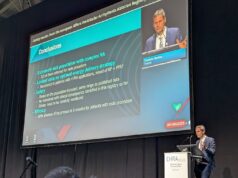
A prospective, multicentre study—THERMOCOOL VT—analysing a cohort of non-randomised patients, published in February in the Journal of the American College of Cardiology, has shown that radiofrequency catheter ablation dramatically reduces ventricular tachycardia episodes and improves quality of life at six months.
The results of the study also show that there was a long-term (three years) reduction in implantable cardioverter defibrillator (ICD) shocks coupled with a significant reduction in hospitalisations and amiodarone use over the same time, but experts are concerned about the 50% rate of arrhythmia recurrence at two years and the 25% mortality at three years in this patient population with advanced structural heart disease.
They have called for further research to evaluate the efficacy and survival associated with ventricular tachycardia ablation when compared with no ablation therapy. They also suggest the need for multidisciplinary heart failure care as an important adjunct to catheter ablation procedures to obtain optimal long-term survival results with catheter ablation.
Francis E Marchlinski, Cardiovascular Division, Hospital of the University of Pennsylvania, Philadelphia, USA, and colleagues, set out to evaluate the long-term safety and effectiveness of radiofrequency catheter ablation using an open-irrigated catheter (NaviStar ThermoCool, Biosense Webster).
The post approval THERMOCOOL VT (NaviStar ThermoCool Catheter for endocardial radiofrequency ablation in patients with ventricular tachycardia) trial evaluated irrigated radiofrequency catheter ablation guided by electroanatomic mapping for recurrent ventricular tachycardia after myocardial infarction. Ablation abolished all inducible ventricular tachycardia in 49% of 231 patients with multiple unmappable ventricular tachycardia caused by previous myocardial infarction. At six months post-ablation, 62% of patients reported freedom from any recurrent ventricular tachycardia. Importantly, tachycardia episodes were significantly reduced in 142 patients with ICD with the frequency of ventricular tachycardia episodes reduced by 75% in 82% of patients. The results of THERMOCOOL VT supported the US FDA’s approval of the open-irrigated catheter for ventricular tachycardia ablation in drug-refractory post-myocardial infarction patients.
Marchlinski and colleagues reported the results of a prospective post-approval study that monitored the long-term safety and effectiveness of radiofrequency ablation using the study catheter for ablation of recurrent ventricular tachycardia in the setting of coronary artery disease.
Patients with sustained ventricular tachycardia, who are at risk for recurrent episodes and sudden cardiac death, have several therapeutic options available to them. While ICD are employed to effectively terminate ventricular tachycardia, shocks are often painful, reduce quality of life, and may increase mortality, the authors write. There are also adjunctive antiarrhythmic medications available that may decrease the number of ICD shocks, but their efficacy is limited and their use is associated with serious adverse events. This makes catheter ablation an alternative approach to ventricular tachycardia prevention.
Marchlinski and colleagues analysed patients with sustained monomorphic ventricular tachycardia associated with coronary disease for cardiovascular-specific adverse events within seven days of treatment. They also studied the duration of hospitalisation, six-month sustained monomorphic ventricular tachycardia recurrence, quality of life measured by the Hospital Anxiety and Depression Scale, one-, two-, and three-year survival, symptomatic tachycardia control, and amiodarone use.
The researchers enrolled 249 patients with a mean age of 67.4 years. They reported that the cardiovascular-specific adverse events rate was 3.9% (nine of 233) with no strokes. They achieved non-inducibility of targeted ventricular tachycardia in nearly 76% of patients and further reported that the median post-ablation hospitalisation was two days. At six months, the investigators found that 62% (114 of 184) of patients had no sustained monomorphic ventricular tachycardia recurrence and that the proportion of patients with ICD shocks decreased from 81.2% to 26.8% (p<0.0001).
As reported in JACC, the frequency of ventricular tachycardia in ICD patients with recurrences was reduced by ≥50% in 63.8% of patients. The proportion of patients with normal Hospital Anxiety and Depression Scale scores increased from 48.8% to 69.1% (p<0.001). The authors wrote that patient-reported ventricular tachycardia remained steady for one, two, and three years at 22.7%, 29.8%, and 24.1%, respectively. Amiodarone use and hospitalisation decreased from 55% and 77.2% pre-ablation to 23.3% and 30.7% at one year, 18.5% and 36.7% at two years and 17.7% and 31.3% at three years.
Based on these results, the authors concluded that radiofrequency catheter ablation reduced ICD shocks and ventricular tachycardia episodes and improved quality of life at six months. “A steady three-year non-recurrence rate with reduced amiodarone use and hospitalisations indicate improved long-term outcomes,” they write.
real value particularly when one notes that results were achieved with low risk and without any procedural related strokes. We also certainly need to recognise the value of catheter ablation in the reduction in costs related to repeated hospitalisation and the dramatic improvement in anxiety and depression scores by eliminating ICD shocks in these patients and use ventricular tachycardia ablation earlier in the patents’ clinical course.”
In an accompanying editorial in the same journal from Andre d’Avila, Hospital Cardiologico, Florianópolis, Santa Catarina, Brazil and Sheldon M Singh, Schulich Heart Program, Sunnybrook Hospital, University of Toronto, Toronto, Canada, note that the last decades have witnessed tremendous growth in the field of catheter ablation, with several studies allowing for a better understanding of the substrate and mechanism of ventricular tachycardia. They also highlight the development of irrigated ablation catheters, sophisticated mapping systems and other technological developments including the use of adjunctive computed tomography/magnetic resonance imaging that have enabled both improved clinical success and decreased periprocedural complications. “Indeed, these gains have resulted in a defined role for ventricular tachycardia ablation in clinical guidelines,” they write.
D’Avila and Singh’s editorial brought to the fore the noteworthy findings from the study including the low rate of procedural complication (around 4%), high rate of acute procedural success (around 76%), improvements in anxiety scores, and a reduction in hospitalisations. While the authors stated that these findings reaffirm the safety and psychological benefits of ventricular tachycardia ablation, they, however, describe the 50% rate of arrhythmia recurrence at two years and 25% mortality at three years as “quite sobering” and “consistent with previous work in this field”. They go on to make the point that this occurred despite a significant reduction in the use of amiodarone, an agent associated with increased mortality in this patient population.
D’Avila and Singh further went on to add that “it is quite possible that the results of this and other ventricular tachycardia ablation studies may deter physicians from referring or performing ventricular tachycardia ablation.” They emphasised that the electrophysiology field needs to be engaged in conducting multicentre matched cohort and randomised studies to evaluate the efficacy and survival associated with ventricular tachycardia ablation when compared with no ablation therapy.
In response to d’Avila and Singh’s editorial, Marchlinski told Cardiac Rhythm News: “In this multicentre real-world experience, not only was there total ventricular tachycardia elimination in 62% but the frequency of ventricular tachycardia episodes was reduced by 75% in 82% of patients at six months. This is a dramatic effect. Furthermore, patients had not only a six-month benefit but also a demonstrated three-year benefit with continued dramatic reduction in ICD shocks and reduction in amiodarone use and hospitalisations by more than 50%. This long-term effect is quite remarkable.”
He added, “that because of the advanced nature of the structural heart disease in patients with ventricular tachycardia enrolled in ventricular tachycardia ablation studies, dramatic improvements in mortality requires larger patient numbers to demonstrate benefit. The International VT Ablation Center Collaborative (IVTCC) group study investigators included over 2,000 patients with structural heart disease to demonstrate a survival benefit in patients with ventricular tachycardia control with ablation as reported in the HeartRhythm journal last year. (Tung R et al, HeartRhythm 2015;12:1997–2007). The 249 patient sample size in our study precluded reaching statistical significance for a mortality endpoint.”
“I can assure you,” he stated, “that nearly all physicians will review these data and judge ablation therapy as having








